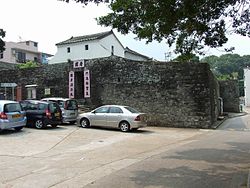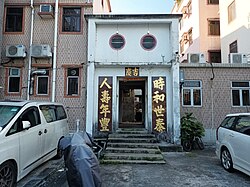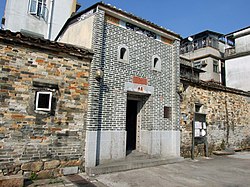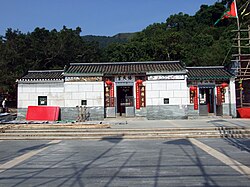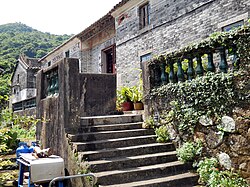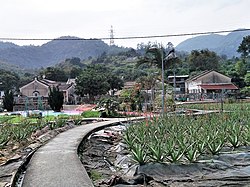Walled villages of Hong Kong
 From Wikipedia - Reading time: 19 min
From Wikipedia - Reading time: 19 min



Most of the walled villages of Hong Kong are located in the New Territories.
History
[edit]During the Ming and Qing dynasties, coastal areas in Guangdong experienced numerous attacks from pirates. The area of present-day Hong Kong was particularly vulnerable to such incursions. The area's winding shores, hilly land, and islands, as well as its distance from administrative centres, made the territory of Hong Kong an excellent hideout for pirates. Villages, both Punti and Hakka, built walls against them. Some villages even protected themselves with cannons. Over time, the walls of most walled villages have been partly or totally demolished.
Names
[edit]In Punti Cantonese, wai (圍, 'walled') and tsuen (村, 'village') were once synonyms. Most place names which include the word wai were at some point in time a walled village.
Conservation
[edit]Two heritage trails of Hong Kong feature walled villages:
- Ping Shan Heritage Trail. One walled village: Sheung Cheung Wai (上璋圍).
- Lung Yeuk Tau Heritage Trail. Five walled villages: Lo Wai (老圍), Ma Wat Wai (麻笏圍), San Wai (新圍, also called Kun Lung Wai 覲龍圍), Tung Kok Wai (東閣圍, also known as Ling Kok Wai), Wing Ning Wai (永寧圍).[1]
Features
[edit]Walled villages in Hong Kong are characterised by row houses arranged in a square or rectangular block, where the parallel rows of houses are separated by narrow lanes.[2]
-
Entrance gate of Nam Pin Wai
-
Central axis of Sheung Cheung Wai
-
Tu Di Gong shrine within the entrance gate of Tsing Chuen Wai
-
A narrow lane in Lam Tei Tsuen, typical of Hong Kong walled villages
-
Village shrine of Mong Tseng Wai, at the end of the central axis
-
Wall of San Wai aka. Kun Lung Wai
-
Wall of Kat Hing Wai
-
Wall of Fui Sha Wai, Tai Hang
-
Wall of Lo Wai
-
Village pond of Fanling Ching Wai
Notable walled villages
[edit]Kat Hing Wai
[edit]
Kat Hing Wai (吉慶圍) is a noted Punti walled village in Yuen Long District of Hong Kong.[citation needed] It often mistakenly believed to be Hakka, whose people have similar traditions.[citation needed] However the Punti people were from Southern China and the first to settle in Hong Kong. Kat Hing Wai's residents speak Cantonese, rather than Hakka.[citation needed] Popularly known as Kam Tin, from the name of the area, it is home to about 400 descendants of the Tang Clan, who built the village back in the 17th century.
Kat Hing Wai is a rectangular (100 m x 90 m) walled village. As a family stronghold, Kat Hing Wai has served the Tangs well through the centuries, protecting the residents against bandits, rival clans, and wild tigers. During the Qing dynasty, a five-metre high blue brick wall and four cannon towers were added to defend against bandits. Today, the village is still completely surrounded by 18-inch-thick walls,[citation needed] outside which are the remains of a moat. However, most houses within the walls have been rebuilt in recent years. There is only one narrow entrance, with a pair of iron gates.
Tsang Tai Uk
[edit]
Tsang Tai Uk (曾大屋), also known as Shan Ha Wai (山下圍),[3] is another well-known Hakka walled village in Hong Kong, and one of the best preserved. It is located in Sha Tin, close to the south of the Pok Hong Estate, not far from the Lion Rock Tunnel Road. Built as a stronghold for the Tsang Clan, its construction started in 1847 and took around 20 years to complete. The village is built with granite, grey bricks, and solid timber.
Sheung Shui Wai
[edit]Sheung Shui Wai (上水圍), also known as Sheung Shui Heung (上水鄉), is one of the very few rural settlements having retained its original moat which was built in 1646. Characterized by its magnificent moat and landscape setting, the walled village is the core of the Liu clan, of which ancestors came originally from Fujian during the Yuan dynasty (1271–1368). The village is located in Sheung Shui.
Fanling Wai
[edit]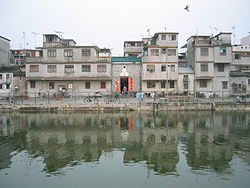
Fanling Wai (粉嶺圍) is a walled village in Fanling built by the Pang (彭) Clan. It is recognisable with the distinctive pond and layout including features such as cannons and watchtowers. All these elements were crafted to form an integral part of the village setting. Fanling Wai is the centre of the Pang Clan who arrived in Hong Kong late during the Song dynasty.[4]
Nga Tsin Wai Tsuen
[edit]Nga Tsin Wai Tsuen (衙前圍村) is a walled village in Wong Tai Sin, New Kowloon. It is the only walled village left in the urban built-up areas of Hong Kong. Nga Tsin Wai Tsuen is also the only remaining walled village in Kowloon. It is located near San Po Kong. On 18 July 2007, the government announced its plans to redevelop Nga Tsin Wai Tsuen.[5]
List of walled villages
[edit]Remaining walled villages in Hong Kong include:
North District
[edit]Sha Tin District
[edit]| Name | Alternate name | Area and coordinates |
Notes | Gate | Shrine or ancestral hall |
Watch tower |
|---|---|---|---|---|---|---|
| Tsang Tai Uk (曾大屋) |
Shan Ha Wai (山下圍)[3] |
Sha Tin 22°22′26″N 114°11′26″E / 22.3738°N 114.1906°E |
(see "Notable walled villages" above) |  |
 |
 |
| Chik Chuen Wai (積存圍) |
Tai Wai (大圍) |
Tai Wai 22°22′35″N 114°10′44″E / 22.376275°N 114.178783°E |
 |
 |
||
| Tin Sam Wai (田心圍) |
Tai Wai 22°22′09″N 114°10′40″E / 22.369298°N 114.177826°E |
Tin Sam was founded during the late Ming dynasty.[24] Historic buildings in the village include the Choi,[25][26] Leung[27][28] and Liu ancestral halls,[25] and the Entrance Gate, built during the Qing dynasty.[29] |  |
Tai Po District
[edit]| Name | Alternate name | Area and coordinates |
Notes | Gate | Shrine or ancestral hall |
Watch tower |
|---|---|---|---|---|---|---|
| Kei Ling Ha Lo Wai (企嶺下老圍) |
Shap Sze Heung, Sai Kung Peninsula 22°24′40″N 114°16′27″E / 22.411001°N 114.274177°E |
 |
 |
|||
| Chung Sum Wai (中心圍) |
Tsing Chuen Wai (青磚圍) |
Tai Hang (Tai Po) 22°28′09″N 114°08′59″E / 22.469228°N 114.149808°E |
 |
 | ||
| Fui Sha Wai (灰沙圍) |
Tai Hang (Tai Po) 22°28′12″N 114°09′06″E / 22.469915°N 114.151535°E |
The walls of Fui Sha Wai were built by the local villagers during the mid-Ming dynasty. Four watchtowers were built in each corner for fortification. Nowadays, Fui Sha Wai still remains as a village exclusively for the Man clan. | 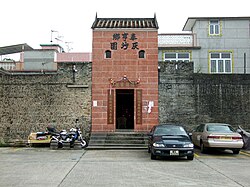 |
 | ||
| Pan Chung (泮涌) |
Tai Po 22°26′43″N 114°09′57″E / 22.445308°N 114.165748°E |
A multi-clan village. [2] [3] #1403 |
 |
 |
||
| Tai Po Tau Shui Wai (大埔頭水圍) |
Tai Po Tau Lo Wai (大埔頭老圍)[30] |
Tai Wo 22°27′09″N 114°09′27″E / 22.452524°N 114.157438°E |
Tai Po Tau Shui Wai was established during the Song dynasty by a branch of the Tang Clan of Kam Tin. The enclosing walls were constructed during the Ming dynasty.[30] |  |
 |
 |
Tsuen Wan District
[edit]| Name | Alternate name | Area and coordinates |
Notes | Gate | Shrine or ancestral hall |
Watch tower |
|---|---|---|---|---|---|---|
| Sam Tung Uk (三棟屋) |
Tsuen Wan 22°22′19″N 114°07′13″E / 22.371934°N 114.120223°E |
The former Hakka walled village has been converted into the Sam Tung Uk Museum, and is now a declared monument. |  |
 |
Tuen Mun District
[edit]| Name | Alternate name | Area and coordinates |
Notes | Gate | Shrine or ancestral hall |
Watch tower |
|---|---|---|---|---|---|---|
| Chung Uk Tsuen (鍾屋村) |
Kwong Tin Wai (廣田圍) |
Lam Tei 22°25′44″N 113°59′33″E / 22.428791°N 113.992418°E |
The Chungs of Chung Uk Tsuen moved from Dongguan during the Ming dynasty.[31] |  |
 |
|
| Lam Tei Tsuen (藍地村) |
Wing On Tsuen (永安村) |
Lam Tei 22°25′09″N 113°59′02″E / 22.419186°N 113.984023°E |
Established by the To (陶) Clan[32] |  |
 |
|
| Nai Wai (泥圍) |
Wong Kong Wai (黃崗圍)[32] |
Lam Tei 22°25′24″N 113°59′19″E / 22.423307°N 113.988609°E |
Established by the To (陶) Clan[32] |
 |
 |
 |
| Sun Fung Wai (順風圍) |
(順豐圍) | Lam Tei 22°25′28″N 113°59′19″E / 22.424334°N 113.988679°E |
A multi-lineage village established around 300 years ago.[33] |
 |
 |
 |
| Tsing Chuen Wai (青磚圍) |
Mak Yuen Wai (麥園圍)[32] |
Lam Tei 22°25′22″N 113°58′55″E / 22.422667°N 113.981861°E |
Established by the To (陶) Clan about 300 years ago. Tin Hau, Kwan Tai and a Qing official are worshipped in the village shrine. |
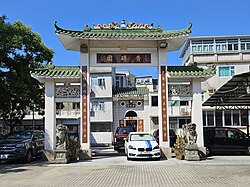 |
 |
 |
| Tuen Mun San Tsuen (屯門新村) |
San Tsuen Wai (新村圍) Tai Yuen Wai (大園圍)[32] |
Lam Tei 22°25′06″N 113°59′04″E / 22.418229°N 113.984436°E |
Established by the To (陶) Clan[32] |  |
 |
|
| Tuen Tsz Wai (屯子圍) |
Tin Tsz Wai (田子圍)[32][34] |
Lam Tei 22°25′18″N 113°58′53″E / 22.42174°N 113.98127°E |
The village was built by the Siu (蕭) Clan. It was later settled by the To (陶) Clan during the Qing dynasty.[35] The entrance gate was demolished and was rebuilt further east for feng shui reasons.[34] |  |
 |
 |
Wong Tai Sin District
[edit]| Name | Alternate name | Area | Notes | Gate | Shrine | Coordinates and References |
|---|---|---|---|---|---|---|
| Nga Tsin Wai Tsuen (衙前圍村) |
Hing Yau Yu Tsuen (慶有餘村)
|
Wong Tai Sin 22°20′06″N 114°11′36″E / 22.335042°N 114.193354°E |
See also "Notable walled villages" above. |  |
 |
 |
Yuen Long District
[edit]Unconfirmed
[edit]The following villages are likely to have been walled villages, although it is not confirmed:[46]
| Name | Alternate name | Area and coordinates |
Notes | Gate | Shrine or ancestral hall |
Watch tower |
|---|---|---|---|---|---|---|
| Sai Tau Wai (西頭圍) |
Wang Chau, Yuen Long District 22°27′11″N 114°01′33″E / 22.452931°N 114.025916°E |
 |
||||
| Tsz Tin Wai (子田圍) |
Lam Tei, Tuen Mun District 22°24′58″N 113°58′29″E / 22.416147°N 113.974632°E |
The village has been engulfed by Tsz Tin Tsuen (紫田村) |  |
Other fenced villages
[edit]A number of old villages in Hong Kong have a wall, built for defensive or feng shui purposes, and an entrance gate, but are not considered as traditional walled villages. They include:
Non-walled 'wai'
[edit]The following villages are neither current nor former walled villages, despite the wai in their name:[46]
- Fan Ling Nam Wai (粉嶺南圍)
- Fan Ling Pak Wai (粉嶺北圍)
- Fung Ka Wai (馮家圍)
- Ha Wai (下圍)
- Hok Tau Wai (鶴數圍)
- Kam Tsin Wai (金錢圍)
- Kan Tau Wai (簡頭圍)
- Kat O Sheung Wai (吉澳上圍)
- Kau Lung Hang Kau Wai (九龍坑舊圍)
- Kau Lung Hang San Wai (九龍坑新圍)
- Kau Shi Wai (狗屎圍), renamed Fung Mei Wai (鳯美圍)
- Kei Ling Ha San Wai (企嶺下新圍)
- Kei Lun Wai (麒麟圍)
- Lo Wai (Tsuen Wan) (老圍(荃灣))
- Luk Keng Ha Wai (鹿頸下圍)
- Luk Keng Sheung Wai (鹿頸上圍)
- Mai Po Lo Wai (米埔老圍)
- Nam Pin Wai (Sai Kung) (南邊圍(西貢))
- Nam Wai (南圍)
- Pak Wai (Kam Tin) (北圍(錦田))
- Pak Wai (Sai Kung) (北圍(西貢))
- Pui O Lo Wai (貝澳老圍)
- San Lung Wai (新隆圍)
- San Tin Ha San Wai (新田下新圍)
- San Tin Sheung San Wai (新田上新圍)
- Sha Lo Tung Lo Wai (沙螺洞老圍)
- Sha Tin Wai (沙田圍)
- Shek Pok Wai (石壆圍)
- Shek Tau Wai (石頭圍)
- Sheung Kwai Chung Wai (上癸涌圍)
- Shui Tsiu Lo Wai (水蕉老圍)
- So Kwun Wat Lo Wai (掃管笏老圍)
- Tai Po Kau Lo Wai (大埔滘老圍)
- Tai Po Kau San Wai (大埔滘新圍)
- Tai Shang Wai (大生圍)
- Tap Mun Chung Wai (塔門中圍)
- Tap Mun Ha Wai (塔門下圍)
- Tap Mun Sheung Wai (塔門上圍)
- To Yuen Wai (桃園圍)
- Tseng Tau Wai (井頭圍)
- Tsing Chuen Wai (Yuen Long) (靑磚圍(元朗))
- Tsiu Keng Lo Wai (蕉徑老圍)
- Tsiu Keng San Wai (蕉徑新圍)
- Tung Chan Wai (東鎭圍)
- Tung Tau Wai (東頭圍)
- Wong Chuk Hang San Wai (黃竹坑新圍)
- Wong Ka Wai (黃家圍)
- Wu Kau Tang Lo Wai (烏蛟滕老圍)
See also
[edit]- Housing in Hong Kong
- History of Hong Kong
- List of villages in Hong Kong
- Chinese clan
- Weitou dialect
- Dapengcheng, a walled village in Shenzhen
- Hakka walled village
- Kowloon Walled City
References
[edit]- ^ a b c d e f g h Antiquities and Monuments Office. Lung Yeuk Tau Heritage Trail
- ^ Jeffrey W. Cody and James R. Richardson (1997). "Urbanizing forest and Village Trees in Hong Kong's Sha Tin Valley, 1976–1997" (PDF). Traditional Dwellings and Settlements Review. IX (1): 24. Archived from the original (PDF) on 9 January 2016.
- ^ a b Hill, Ronald D. (1985). "Fragments and speculations: the walled villages of Hong Kong". Journal of the Hong Kong Archaeological Society. 11. Hong Kong Archaeological Society: 25-38. OCLC 02465191.
- ^ Planning Department – Historical Background
- ^ HK Yahoo News
- ^ Antiquities Advisory Board. Historic Building Appraisal: Hung Shing Temple, Hung Leng Tsuen
- ^ a b c Agreement No. CE 45/2008 (CE) Liantang / Heung Yuen Wai Boundary Control Point and Associated Works -Environmental Impact Assessment Report. Appendix 12.2f: Detailed Records of Identified Built Heritage Features within CHIA Study Area of the Lau Shui Heung Tunnel Section (South Tunnel)
- ^ Antiquities and Monuments Office: Ma Wat Wai: Declared monument on AMO website
- ^ Antiquities and Monuments Office. Lung Yeuk Tau Heritage Trail - Ma Wat Wai
- ^ Antiquities and Monuments Office: Kun Lung Gate Tower: Declared monument
- ^ Antiquities and Monuments Office: Kun Lung Walls
- ^ Antiquities and Monuments Office. Lung Yeuk Tau Heritage Trail - San Wai
- ^ Antiquities and Monuments Office. Lung Yeuk Tau Heritage Trail - Tung Kok Wai
- ^ Antiquities Advisory Board. Historic Building Appraisal. Tung Kok Wai, Lung Yeuk Tau
- ^ Antiquities and Monuments Office. Lung Yeuk Tau Heritage Trail. Lung Yeuk Tau Heritage Trail - Wing Ning Wai
- ^ Antiquities Advisory Board. Historic Building Appraisal: Hakka Wai – Residential Houses
- ^ Antiquities and Monuments Office: Ho Sheung Heung: History
- ^ Lonely Planet: Ping Kong
- ^ Chinese Temples Committee: Tin Hau Temple, Ping Kong
- ^ Antiquities and Monuments Offices: Ha Pak Tsuen – History
- ^ Christopher DeWolf, "At the end of the line: Sheung Shui Village", CNN GO, 5 May, 2010
- ^ Planning Department: Fanling & Sheung Shui – Historical Background
- ^ East Rail Extension Project: Test Pits Results and Cross-Section Drawings. Items #219, 220, 221 on map: [1]
- ^ Antiquities Advisory Board. Historic Building Appraisal: Entrance Gate, Tin Sam
- ^ a b Antiquities Advisory Board. Historic Building Appraisal: Choi Ancestral Hall, No. 142 Tin Sam
- ^ Antiquities Advisory Board. Historic Building Appraisal: Che Kung Temple, Che Kung Miu Road, Tai Wai
- ^ SCL – NEX/2206 EIA Study for Tai Wai to Hung Hom Section. Environmental Impact Assessment Report.Appendix 4.3. Built Heritage Survey. October 2011
- ^ East Rail Extensions – Tai Wai to Ma On Shan. Environmental Impact Assessment Report. Archaeological and Cultural Resources, 1999
- ^ SCL – NEX/2206 EIA Study for Tai Wai to Hung Hom Section, Final Environmental Impact Assessment Report, Figure 4.2.1. Locations of Known Built Heritages (Sheet 1 of 8), October 2011. Shows the location of the historic buildings of Tin Sam Village.
- ^ a b Antiquities and Monuments Office: Tai Po Tau Shui Wai
- ^ Brief Information_ on proposed Grade III Items. Item #689 Archived 21 March 2012 at the Wayback Machine
- ^ a b c d e f g Antiquities and Monuments Office: Tsing Chuen Wai – History
- ^ Brief Information on proposed Grade III Items. Item #875 Archived 21 March 2012 at the Wayback Machine
- ^ a b Tuen Tsz Wai Building Complex, Hulu Culture
- ^ Antiquities and Monuments Office: Tuen Tsz Wai – History
- ^ Antiquities Advisory Board. Historic Building Appraisal. Yeung Hau Temple, San Wai, Ha Tsuen
- ^ a b "Ha Tsuen Tang Clan's Historic Building compound". Hulu Culture.
- ^ a b Antiquities Advisory Board. Historic Building Appraisal. Entrance Gate, Wing Lung Wai, Kam Tin
- ^ a b c Antiquities and Monuments Office: Ping Shan Heritage Trail
- ^ Antiquities and Monuments Office: Sheung Cheung Wai
- ^ Antiquities Advisory Board. Historic Building Appraisal: Entrance Gate, Sheung Cheung Wai, Hang Tau Tsuen
- ^ Brief history of Shan Ha Tsuen
- ^ Introduction to 1444 Historic Buildings, p.913
- ^ Antiquities Advisory Board. Historic Building Appraisal: Entrance Gate, Tai Wai Tsuen, Yuen Long
- ^ Antiquities Advisory Board. Historic Building Appraisal: No. 24 Lee Yick Street, Yuen Long Kau Hui
- ^ a b Ip, Hing-fong (1995). An historical geography of the walled villages of Hong Kong (Postgraduate Thesis, Master of Philosophy). University of Hong Kong.
- ^ Antiquities Advisory Board. Historic Building Appraisal. Entrance Gate, Pak Mong
- ^ Antiquities Advisory Board. Historic Building Appraisal. Entrance Gate, Sha Lo Wan Tsuen
- ^ Antiquities and Monuments Office. Lung Yeuk Tau Heritage Trail - Siu Hang Tsuen
- ^ Antiquities and Monuments Office. Historic Building Appraisal. Entrance Gate, Tai Tseng Ng Uk Tsuen
Further reading
[edit]- Ali, Jason R.; Hill, Ronald D. (2005). "Feng Shui and the orientation of traditional villages in the New Territories, Hong Kong" (PDF). Journal of the Royal Asiatic Society Hong Kong Branch. 45: 27–39. ISSN 1991-7295.
- Chan, Chi Sing Rex (2006). "Transformation of Two Walled Villages in Kam Tin" (PDF). HKIA Journal. 46. Hong Kong Institute of Architects: 56–58.
- Hill, Ronald D. (1984). "Fragments and speculations: the walled villages of Hong Kong". Journal of the Hong Kong Archaeological Society. 11. Hong Kong Archaeological Society: 25-38. OCLC 02465191.
- Ip, Hing-fong (1995). An historical geography of the walled villages of Hong Kong (Postgraduate Thesis, Master of Philosophy). University of Hong Kong.
- Wang, Weijen (December 1998). "Axial Inversion – the transformation of the spatial structure and its ritual axis in Hong Kong's walled villages" (PDF). Hong Kong Papers in Design and Development. 1: 26–33.
 KSF
KSF


















